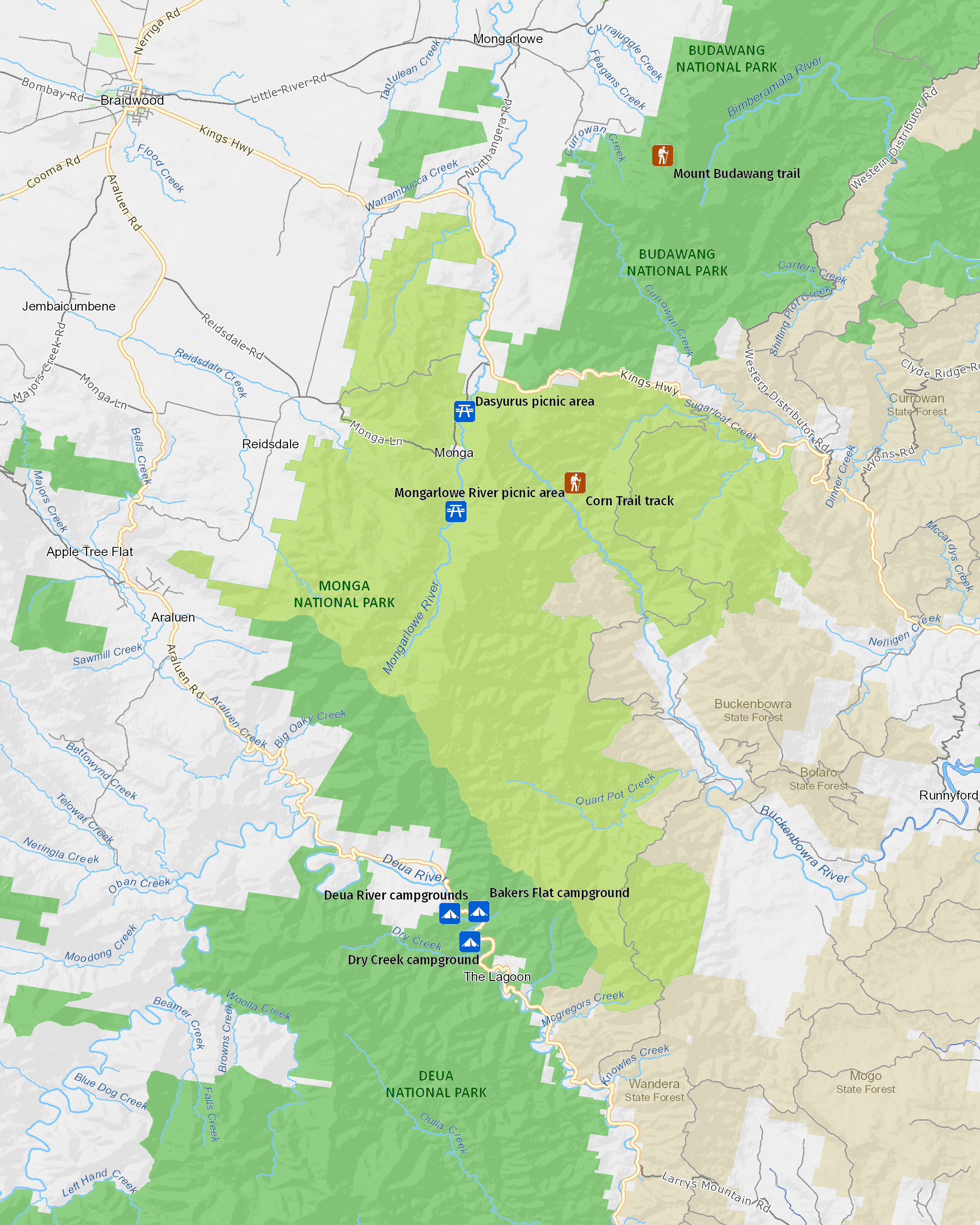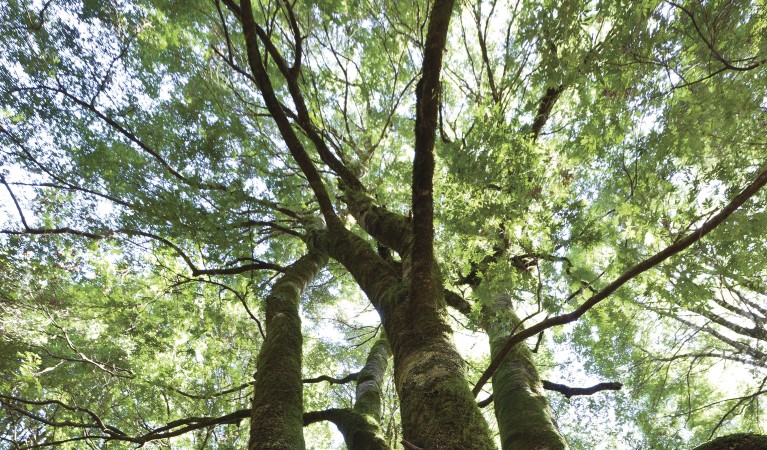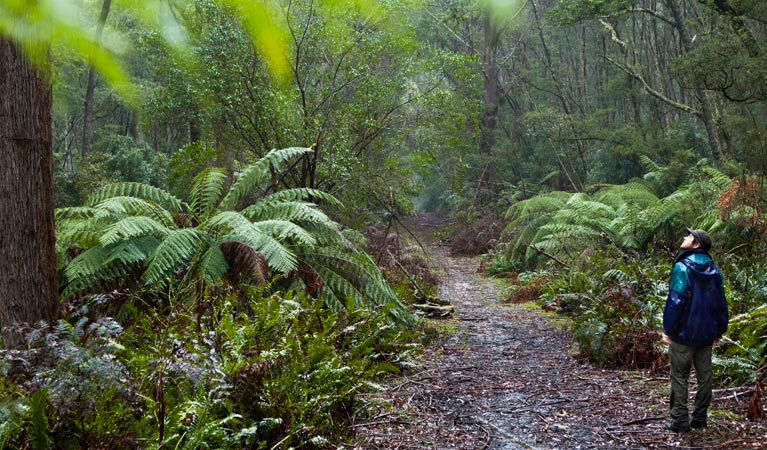Monga National Park
Open, check current alerts
Overview
Monga National Park has something for all, with 4WD touring routes, walking and horse riding tracks to enjoy, peaceful picnic areas, and ancient forests to discover.
Read more about Monga National Park
Whether you’re looking for a tranquil place to enjoy lunch, a challenging full day hike, or a scenic drive, there’s something for everyone at Monga National Park.
Spend the day horse riding and walking in the footsteps of European settlers and Aboriginal tribes on the historic Corn Trail walking track. Or enjoy a picnic along the banks of Mongarlowe River, as you watch the local wildlife and admire the unique Monga waratahs in flower.
As you explore the park, you’ll disccover cool temperate rainforest filled with ancient plumwood trees from the Gondwana Age, warm temperate rainforests and old growth eucalypt forests.
Whatever you choose to do, you’ll leave Monga feeling refreshed and rejuvenated by this beautiful pocket of soothing wilderness.
Local alerts
For the latest updates on fires, closures and other alerts in this area, see https://www.nationalparks.nsw.gov.au/visit-a-park/parks/monga-national-park/local-alerts
Contact
- in the South Coast and Country NSW regions
Monga is always open but may have to close at times due to poor weather or fire danger.
-
-
Narooma office
02 4476 0800
Contact hours: Monday to Friday, 9am to 4pm. Office open by appointment only. Closed public holidays. - 10 Graham Street, Narooma NSW 2546
-
Email: npws.eurobodalla@environment.nsw.gov.au
-
Narooma office
Visitor info
All the practical information you need to know about Monga National Park.
Map

Map legend

Getting there and parking
Get driving directions
From Braidwood:
- Travel east along Kings Highway towards Batemans Bay
- After approximately 20km, turn right into River Forest Road.
- After approximately 2km, you’ll enter the park.
From Batemans Bay :
- Travel west along Kings Highway towards Braidwood
- After approximately 40km, turn left into River Forest Road.
- After approximately 2km, you’ll enter the park.
Parking
- Dasyurus picnic area See on map
- Mongarlowe River picnic area See on map
By bike
Check out the Bicycle information for NSW website for more information.
By public transport
Monga is not accessible by public transport. The closest bus stop is in Braidwood. For information about public transport options, visit the NSW country transport info website.
Best times to visit
There are lots of great things waiting for you in Monga National Park. Here are some of the highlights.
Autumn
Take in the sweet perfumes of the plumwood trees in flower.
Spring
See the distinctive bright red colour of the Monga waratah in bloom along the banks of Mongarlowe River.
Summer
Enjoy a picnic under the shade of the eucalypt forest and unwind to the sounds of the gently flowing water at Mongarlowe River picnic area.
Winter
Embark on the historic Corn Trail walking track and experience the diverse natural landscapes of Monga.
Weather, temperature and rainfall
Summer temperature
Average
10°C and 26°C
Highest recorded
41.1°C
Winter temperature
Average
0°C and 11°C
Lowest recorded
-9.2°C
Rainfall
Wettest month
March
Driest month
July
The area’s highest recorded rainfall in one day
663.9mm
Facilities
Toilets
Picnic tables
Barbecue facilities
Maps and downloads
Prohibited
It’s a legal offence to drive an unregistered motor vehicle or motorcycle on any NSW road or in a NSW national park.
Pets
Pets and domestic animals (other than certified assistance animals) are not permitted. Find out which regional parks allow dog walking and see the pets in parks policy for more information.
Smoking
NSW national parks are no smoking areas.
Nearby towns
Braidwood (22 km)
Braidwood was the first town to be listed on the NSW State Heritage register. Today, you can tour the town on a self-guided heritage walk and see dozens of impressive historic buildings dating from the gold-rush days.
Batemans Bay (31 km)
Batemans Bay is a bustling coastal town with majestic seascapes. It's located on the estuary of the Clyde River.
Moruya (57 km)
Moruya is a historic dairy town on the Moruya River surrounded by dairy pastures and rugged national parks.
Learn more
Monga National Park is a special place. Here are just some of the reasons why:
Unique plantlife

Many of the plants you'll find in the cool, temperate rainforests of Monga are millions of years in the making. Related to the plants from the super continent Gondwana, they present a unique window to the past. The plumwood trees and soft tree ferns you see in the park are closely related to pollen fossils found in Antarctica. Some plumwood trees here have widths of up to 4m and are thought to be thousands of years old. Wander along the banks of Mongarlowe River and you'll also see the distinctive bright red flowers of the Monga waratah.
- Dasyurus picnic area Dasyurus picnic area is a tranquil spot to stop on your drive to the coast from Canberra or a great day trip from Batemans Bay or Braidwood.
- Mongarlowe River picnic area Under the shade of eucalypt forest, this sheltered picnic site is an ideal place to start exploring Monga's rich habitats with easy strolls, swimming, and birdwatching.
Aboriginal culture

For over 14,000 years, the Yuin and Walbunja people have lived around the valleys of Clyde, Deua and Buckenbowra rivers. Walkers and horse riders can walk in their footsteps on Corn Trail walking track, which was one of the trails used by Aboriginal people to travel between the coast and the tablelands. There are many Aboriginal cultural sites in the park where stone artefacts, fire beacons and old campsites have been found.
A glimpse of trading history

Monga National Park is significant for its natural wonders and its historic heritage. Corn Trail walking track, which is today enjoyed by bushwalkers and horse riders, was the first trade route between the Buckenbowra Valley farmlands near the coast and the early European settlements on the tablelands near Braidwood. Further settlement came to the area in the 1840s, with the establishment of the timber trade and gold mining. The sawmill at Monga provided timber for Braidwood and the establishment of Canberra in the 1900s, with logging continuing in the area until 1987.
- Corn Trail walking track Corn Trail walking track is a historic trail for hikers and horse riders to traverse a wide variety of landscapes and follow in the footsteps of the past.
Plants and animals protected in this park
Animals
-

Short-beaked echidna (Tachyglossus aculeatus)
One of only 2 egg-laying mammals in the world, the short-beaked echidna is one of the most widespread of Australian native animals. Covered in spines, or quills, they’re equipped with a keen sense of smell and a tube-like snout which they use to break apart termite mounds in search of ants.
-

Platypus (Ornithorhynchus anatinus)
One of the most fascinating and unusual Australian animals, the duck-billed platypus, along with the echidna, are the only known monotremes, or egg-laying mammals, in existence. The platypus is generally found in permanent river systems and lakes in southern and eastern NSW and east and west of the Great Dividing Range.
-

Grey-headed flying-fox (Pteropus poliocephalus)
The grey-headed flying fox is Australia's largest native bat, with a wingspan up to 1m. This threatened species travels up and down south-eastern Australia and plays a vital role in pollinating plants and spreading seeds in our native forests.
-

Spotted-tailed quoll (Dasyurus maculatus)
The spotted-tailed quoll is the largest remaining carnivorous marsupial on the Australian mainland. It’s protected as a vulnerable species in NSW.
Plants
-

Waratah (Telopea speciosissima)
The beautiful waratah is not only the NSW floral emblem, it's also one of the best-known Australian native plants. This iconic Australian bush flower can be found on sandstone ridges around Sydney, in nearby mountain ranges and on the NSW South Coast. The waratah has a vibrant crimson flowerhead, measuring up to 15cm across, and blossoms in spring.
What we're doing
Monga National Park has management strategies in place to protect and conserve the values of this park. View the detailed park and fire management documents.

